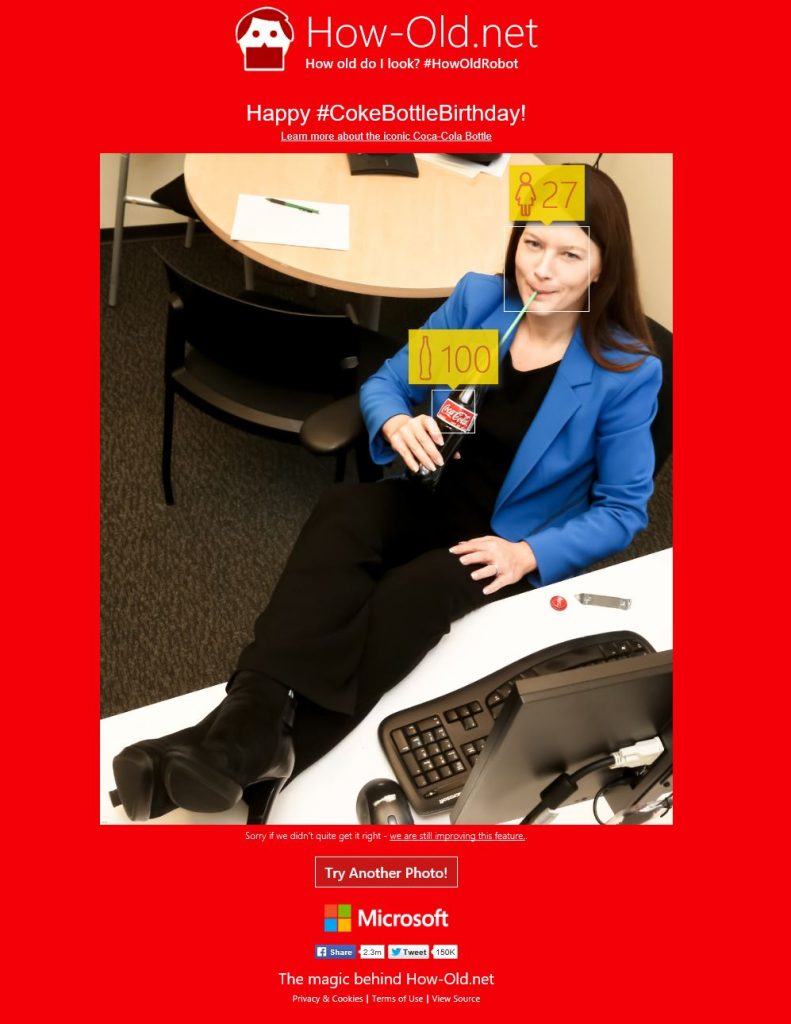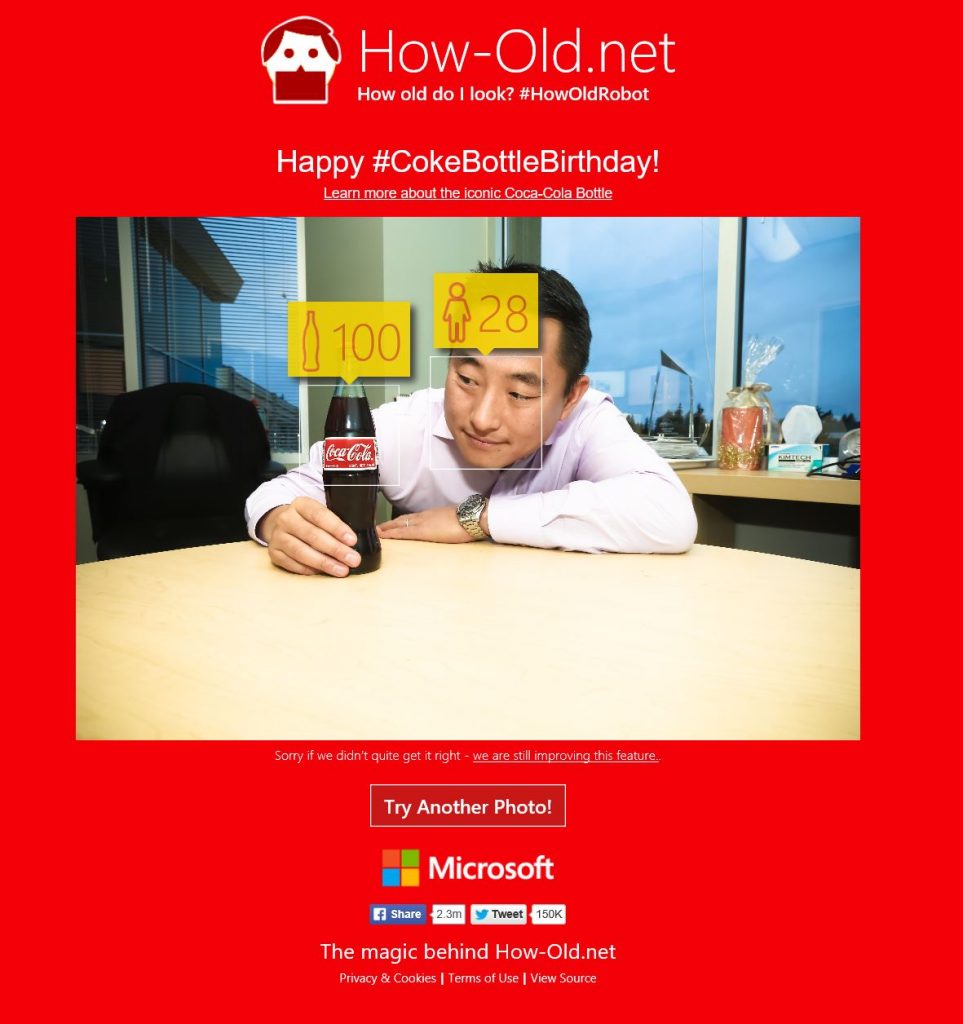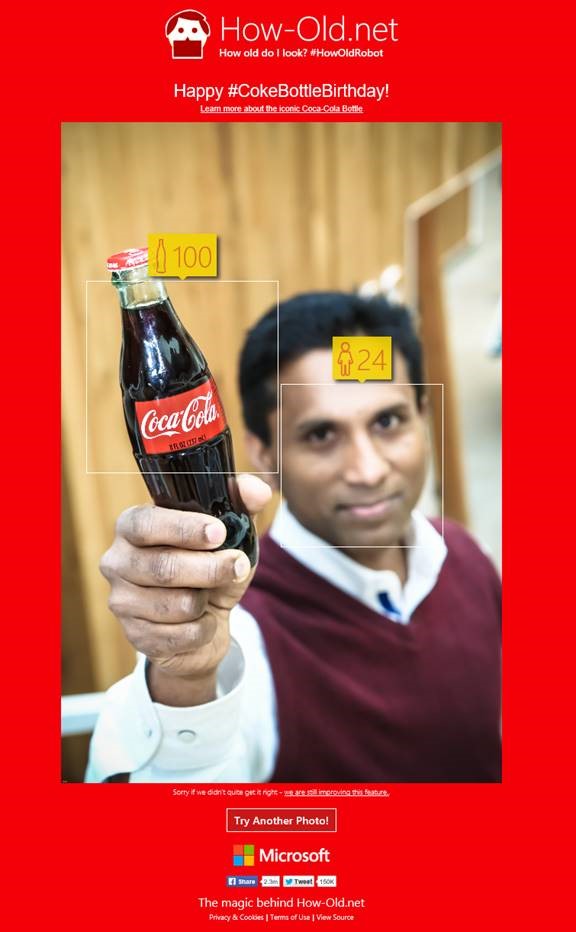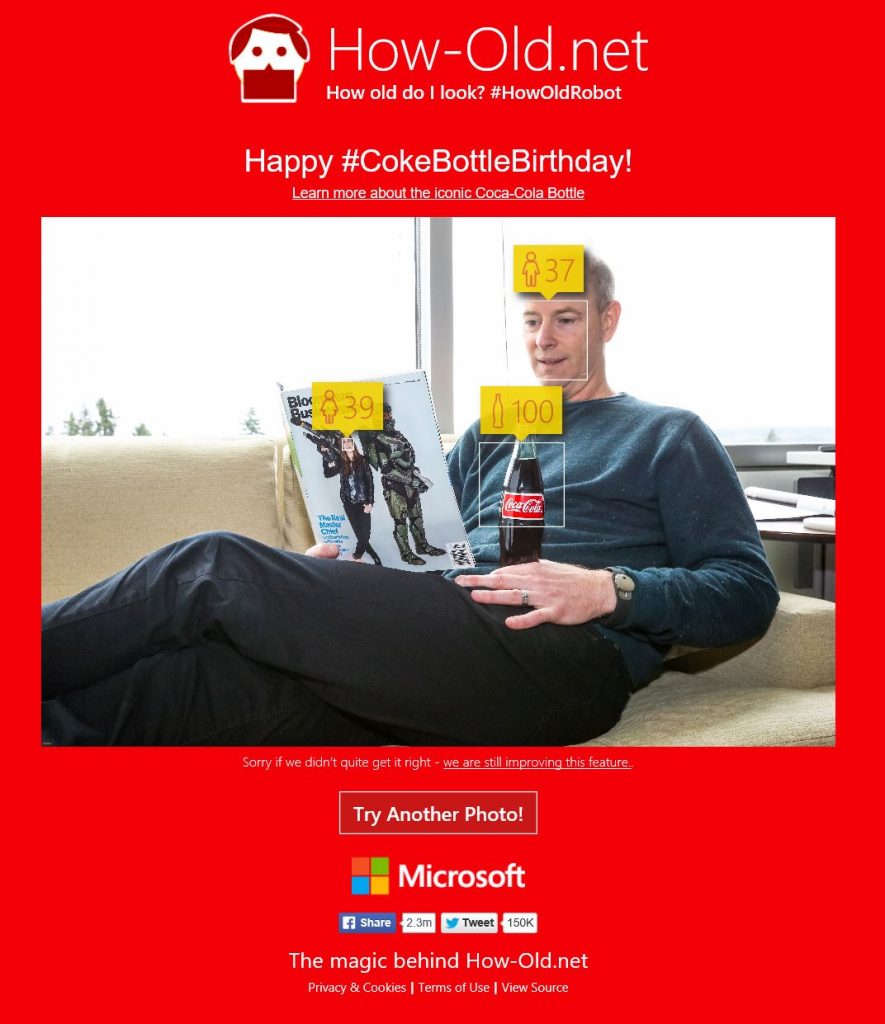
Have a Coke, take a photo and celebrate the Coke bottle’s 100th anniversary using How-Old.net
A few months ago, the Microsoft team behind How-Old.net unleashed an unexpected viral sensation, with more than 575 million images submitted to test the power of real-time analytics and machine learning in guessing the ages of people in those pictures. More than 85 million users visited the site from all over the world.
Coca-Cola patented its distinctive bottle design in 1915, and it’s as likely to be the go-to for families out and about now as it was for parasol-carrying ladies sipping them out of straws a century ago. Coke bottles reached soldiers serving in World War II, appeared in Time in 1950 (the first commercial product to appear on the magazine’s cover) and have endured as a staple through generations.
To celebrate its 100th anniversary, Coca-Cola and Microsoft have partnered to create an original experience inspired by How-Old.net. Coke fans are invited to upload a photo that includes a glass contour Coke bottle, or simply the bottle itself, to How-Old.net to unlock a surprise.
“In this tool we saw an innovative way to capitalize on one of the most iconic brand moments there is as we celebrated this birthday, that moment you share with an ice cold bottle of Coke,” says Simon Cowart, global social media strategist with The Coca-Cola Company.
“We’re onto something that is relatively unique,” says Joseph Sirosh, corporate vice president of the Microsoft Data Group, including the team of engineers who built the Machine Learning and Big Data capabilities that are the heart of Cortana Analytics Suite. Developers on his team were the ones who came up with How-Old.net. Sirosh’s team also worked on the challenge issued by Coca-Cola to take the How-Old.net app one step further by recognizing specific objects, such as a contoured glass Coca-Cola bottle, in pictures users upload.
For the Coca-Cola project, the Microsoft data scientists and engineers started with How-Old.net, and enhanced the experience with the perceptual intelligence capabilities of the Cortana Analytics Suite.
“We had to build a new machine learning model that could recognize Coca Cola bottles,” says Sirosh. “There were two parts to getting this done right: to recognize the Coca-Cola logo and the unique glass contour bottles the logo appears on.”
For the first step, they used Python scripts and image processing libraries, to detect the Coca Cola logo. They then used deep neural networks from Azure Machine Learning to create a dedicated model that can identify whether there’s a bottle in the area surrounding the logo. The scientists trained it with thousands of images collected online and from Coca-Cola, continuously iterating to improve the accuracy of the models through a tool called the Visual Model Evaluator. After all, faces can take up a big part of a photo, while bottles are relatively small. And the logo within it, smaller still.
“The most exciting technology part of this exercise and what we hope to be using down the road is that we created the ability for people in marketing and social communications to augment social campaigns by being able to train a neural network-based machine learning model to detect objects, something that is very, very complex,” Sirosh says. “We made this process incredibly simple, and then integrated it into the How-Old experience. We made a super complex technology available, accessible and usable – and that was a very exciting part of the journey.”
Sirosh thinks this detection technology will be appealing to developers, and is committed to making it easier for anyone to get started with data science.
“Computer vision technology – face recognition – has been around for a while, but only for a select few. Now with the Microsoft Face API, even a developer who knows very little about machine learning or computer vision will be able to set up a website within a week or two that uses sophisticated face recognition technology, and in minutes, create a super fun experience,” Sirosh says. “It’s based on a ton of machine learning, but no one had to fidget around with the machine learning parts.”
How-old.net face recognition is just one example of what’s possible with Microsoft Machine Learning API’s. This machine learning technology is the engine that enables the Web-based gender and age guessing experience that caught on so quickly with How-Old.net.

“Any developer can easily discover and try the capabilities of perceptual intelligence through the Cortana Analytics Gallery,” says Barb Edson, general manager of the Microsoft data marketing group. “It’s a very easy way for a developer to add smart insights into their apps without the need to be an expert in data science.”
And because it runs on Azure, apps using this technology can scale big, fast.
Developers can collate data using Microsoft face APIs, also offered as part of the Cortana Analytics Suite, which incorporates state of the art algorithms from Microsoft Research for facial detection and recognition, gender and age prediction, but also other capabilities such as speech detection and text analysis.
“We’re trying to make this truly a developer experience,” Sirosh says. “We get learnings from detecting all these things and put it into a service that anybody can use to build their own object detection concept.”
Object recognition could find applications in all kinds of ways, such as automatically detecting colors for washing machine cycles, or programming a robot that can detect food in the kitchen, or building a toy that responds only to your child. Gyms could automate workouts for their members (sorry, personal trainers!) and companies could link photos of their products directly to catalog availability. The fitness conscious could even take pictures of their meals, which would reveal nutritional values.
“We didn’t know How-Old would lead us down this path,” Sirosh says. “But now people can see how machine learning can be cool, reaching 85 million people through a single app. People saw us do a pretty cool thing with our technology, and maybe we can help them do something cool, too.”
Read more about how Joseph’s team created the #CokeBottleBirthday experience.
Lead image: Joseph Sirosh, corporate vice president, Microsoft Data Group


















